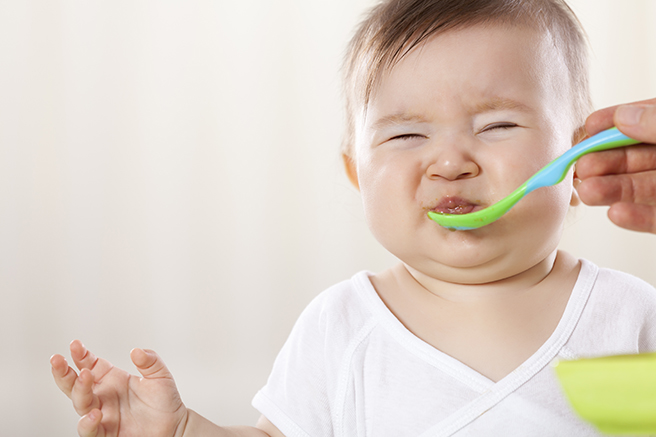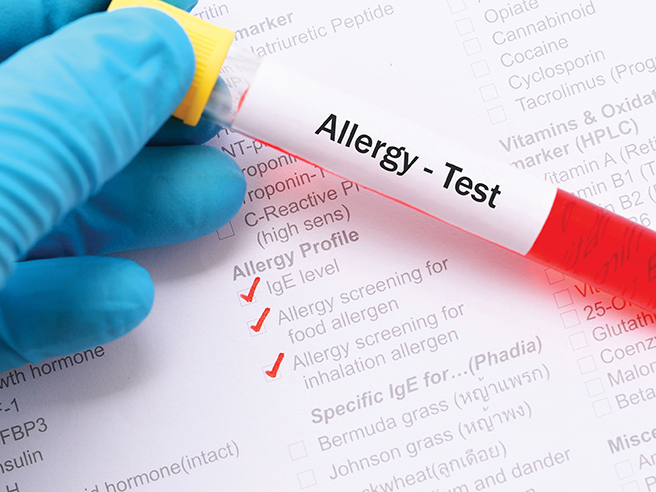Weaning children with food allergies can be challenging and terrifying at the same time, but there are simple and proven ways to overcome these possible concerns…

Introducing your baby to real food for the first time is one of the great joys of parenthood. This process is somewhat complicated if your child is diagnosed with a food allergy. Dr Helen Cox talks us through how to recognise and deal with any of these potential pitfalls.
What are food allergies and when do they occur?
The majority of food allergies present within the first two years of life as infants are introduced to new milk formulas and foods. The reactions can occur at any stage, with some babies reacting within the first few weeks of life. Food allergic reactions occur when the body recognises a food protein as being ‘foreign’. This generates a strong immune response aimed at rejecting that food protein, leading to a range of symptoms affecting different parts of the body. Broadly speaking these immune-mediated reactions can be divided into immediate and
delayed reactions.
Immediate reactions occur within minutes to two hours of eating the food. They can be provoked by minute quantities of food protein which binds to allergen specific mmunoglobulins (IgE) – antibodies produced by the immune system – receptors in the body, leading to the release of histamine and other inflammatory mediators. These reactions occur each and every time the food is given. Allergy tests (skin prick tests and IgE blood tests) are usually positive. The reactions can trigger a range of responses involving the skin, gut, respiratory and cardiovascular systems. Immediate redness and itching of the skin followed by the development of hives (urticaria) occur commonly. This can be accompanied by swelling of the lips, eyes, face hands and feet.
Vomiting also occurs frequently as the body attempts to rid itself of the allergen. Skin reactions usually resolve rapidly after withdrawal of the food allergen, and respond well to treatment with antihistamine. More severe reactions involve either the respiratory or cardiovascular systems. This may lead to the development of breathing difficulties with a persistent cough, wheeze, noisy breathing or voice change due to swelling of the airway.
Alternatively, reactions may lead to a drop in blood pressure resulting in extreme pallor, floppiness, drowsiness or even collapse. These severe reactions are called ‘anaphylaxis’ and require immediate medical attention with the administration of injectable adrenaline.
Delayed reactions to foods are more insidious in onset and therefore more difficult to diagnose. The reactions typically occur within 1-3 days of eating the food, leading to a range of symptoms affecting either the skin or gut. They usually require larger amounts of allergen to provoke a reaction. Allergy tests are usually negative. Typical symptoms can include one or more of the following: eczema, vomiting, reflux, colic, abdominal pain, constipation, diarrhoea, blood or mucous in the stools or faltering growth. Occasionally the vomiting can occur within minutes of eating and be severe and protracted, leading to dehydration and collapse needing urgent medical attention. The term food proteinenterocolitis (FPIES) has been used to describe these reactions, which may be accompanied by bloody stools.
As many of these symptoms can occur in non-allergic infants, it’s often the co-association of features that makes the diagnosis more likely. Faltering growth is a worrying sign of possible malabsorption and requires urgent review. It is worth pointing out, however, that many babies with delayed food allergy have normal growth.
Which foods cause reactions?
Any one of the 14 foods listed by the EU are capable of causing an reaction. In the first two years of life the main culprits are cow’s milk, eggs and nuts, which account for three-quarters of immediate reactions, followed by sesame, wheat, fish, soya, kiwi and rarely, shellfish.
Allergy to pulses (lentils, chickpeas, peas) occur more frequently in Asian and vegan populations, reflecting their higher consumption of these foods. Sulphites very rarely cause adverse reactions in infants.
The list of foods causing delayed reactions is shorter, with four main food proteins causing most reactions. Cow’s milk causes the majority of delayed reactions followed by soya, gluten (wheat, barley, rye, oats) and lastly eggs. Approximately half of all infants with delayed reactions to cow’s milk also react to soya with similar symptoms.
Certain foods such as tomatoes and berries are high in natural histamines leading to mild rashes around the mouth post ingestion. Acidic foods such as pineapples and oranges can also aggravate the skin of a baby with eczema. These foods cause irritation as opposed to allergic reactions.

What to do if you suspect your child is food allergic?
It is best to seek medical help early if you suspect that your child is food allergic. This not only ensures that an accurate diagnosis is made, but also allows your child to progress with their weaning diet in a safe manner while ensuring that their diet is as nutritious and varied as possible. This usually requires the support of a children’s allergy doctor and dietitian.
As allergists, once food allergy is diagnosed, we would actively promote the early introduction and inclusion of a diverse range of ‘permitted foods’ while excluding a baby’s known allergens. In support of this approach, a recent study has found that including peanuts early into the diet of infants with eczema and egg allergy, significantly reduced the risk of having a peanut allergy at five years. In high-risk infants with eczema and/or other food allergies, allergy testing prior to introduction is recommended.
When to allergy test?
Testing food allergens can be carried out in infants from the age of three to four months and to inhalant allergens from the age of 12 months. Both skin prick tests and blood specific IgE tests are able to detect the presence of allergen specific IgE antibodies, and this does not rely upon a prior history of food ingestion. The tests are very useful to diagnose or exclude immediate food allergy. They are also able to assess a child’s risk of reacting to a food not yet introduced. They are particularly useful in infants with moderate to severe eczema, where the tests can help guide decisions regarding dietary elimination and inclusions. They do however require a skilled practitioner to interpret the tests in the light of the clinical history, as the tests are fraught with difficulty with both false positive and false negative reactions occurring. Food challenge tests are often needed where the diagnosis is still uncertain based on borderline test results.
There are no validated tests to diagnose delayed food allergy. Food Intolerance tests measuring IgE antibodies and other alternative tests have no role in the diagnosis of either immediate or delayed food allergy. The diagnosis of delayed allergy is made based on pattern recognition of symptoms followed by the implementation of a trial period of dietary elimination followed by challenge tests. In formula-fed infants with suspected cow’s milk allergy, a prescribed hypoallergenic milk formula may be offered for a trial period.
In breastfed infants, a trial period of removing cow’s milk and soya from the maternal diet for four weeks may be suggested. Dietetic support and maternal calcium supplementation during such dietary implementation is important. Formula milks that are unsuitable for treating cow’s milk allergy in young infants include goat’s milk, lactose-free milk and soya milk, in addition to most anti-reflux formulas which are based on cow’s milk protein.
Which infants are at higher risk of being food allergic?
Having one or both parents with either asthma, hayfever or eczema, or a sibling with food allergy will increase an infant’s risk of food allergy. Being allergic to one food will also increase an infant’s chance of reacting to other foods, with two-thirds of those children being allergic to more than one food. Another high risk group are infants who develop persistent eczema within the first few months of life despite treatment with topical steroids and emollients. The risk rises with increasing eczema severity ranging between 30-60%. These infants are also at greater risk of developing either asthma or hayfever in a progression known as ‘the atopic march’.
Ideally these infants should be referred early for an allergy assessment and testing to inform on the weaning diet. If your baby is deemed to be high risk and is still waiting to be seen by a doctor, then it would be advisable to introduce foods of low allergenic potential first. When introducing foods that are capable of causing an allergic reaction, this needs to be done cautiously, starting with a tiny amount of food touched to the inside of the lip, followed by small amounts of the food given at least an hour apart, in increasing incremental amounts over three days.
I am often struck by how varied and healthy the diets are of children with food allergy who I see in clinic. Dietary restrictions inevitably mean less junk food and more home cooking using fresh ingredients. These following recipes are creative and delicious and can help to wean and feed your allergic baby.
The article first appeared in The Allergy-Free Baby & Toddler Cookbook by Fiona Heggie and Ellie Lux, published by Orion Books. (RRP £20).
